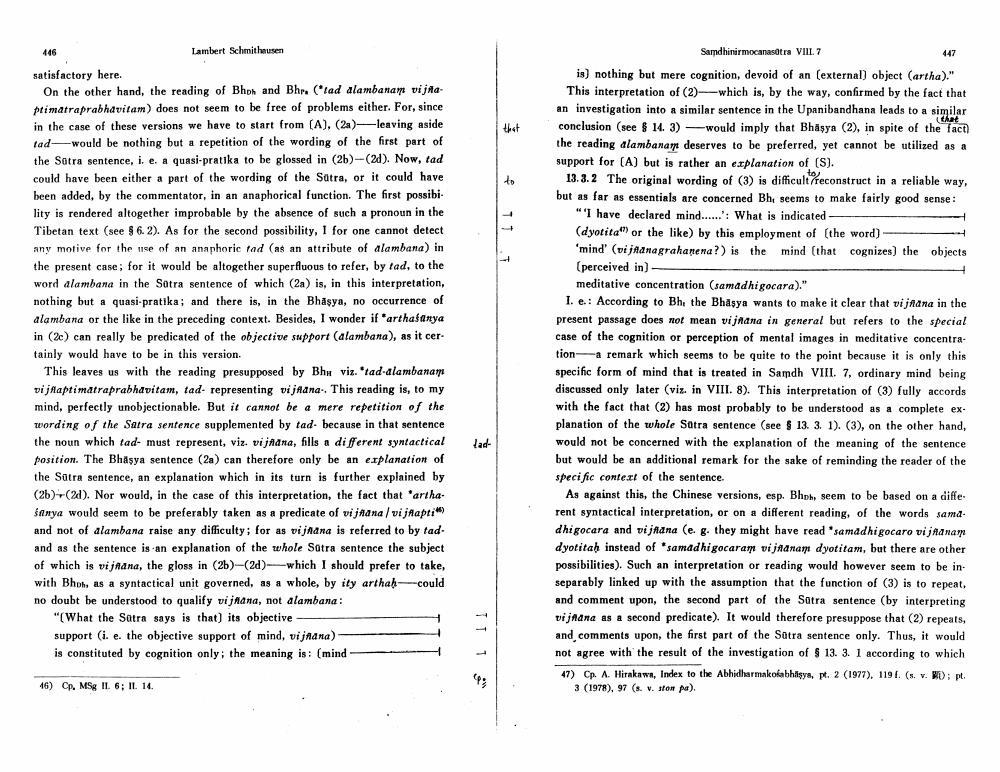Book Title: On Vinaptimatra Passage In Samadhinirmocanasutra VIII Author(s): L Schmithausen Publisher: L Schmithausen View full book textPage 8
________________ 446 Lambert Schmithausen satisfactory here. On the other hand, the reading of Bhoh and Bhr. (*tad alambanam vijñaptimatraprabhavitam) does not seem to be free of problems either. For, since in the case of these versions we have to start from (A), (2a)-leaving aside tad would be nothing but a repetition of the wording of the first part of the Satra sentence, i. e. a quasi-pratika to be glossed in (2b)-(2d). Now, tad could have been either a part of the wording of the Satra, or it could have been added, by the commentator, in an anaphorical function. The first possibility is rendered altogether improbable by the absence of such a pronoun in the Tibetan text (see § 6. 2). As for the second possibility, I for one cannot detect any motive for the use of an anaphoric tad (as an attribute of alambana) in the present case; for it would be altogether superfluous to refer, by tad, to the word alambana in the Sutra sentence of which (2a) is, in this interpretation, nothing but a quasi-pratika; and there is, in the Bhasya, no occurrence of alambana or the like in the preceding context. Besides, I wonder if "arthasanya in (2c) can really be predicated of the objective support (alambana), as it cer tainly would have to be in this version. This leaves us with the reading presupposed by Bha viz. tad-alambanam vijЯlaptimatraprabhavitam, tad- representing vijana-. This reading is, to my mind, perfectly unobjectionable. But it cannot be a mere repetition of the wording of the Satra sentence supplemented by tad- because in that sentence the noun which tad- must represent, viz. vijñana, fills a different syntactical position. The Bhasya sentence (2a) can therefore only be an explanation of the Sutra sentence, an explanation which in its turn is further explained by (2b)+(2d). Nor would, in the case of this interpretation, the fact that 'arthasanya would seem to be preferably taken as a predicate of vijñana | vijñapti" and not of alambana raise any difficulty; for as vijnana is referred to by tadand as the sentence is an explanation of the whole Sutra sentence the subject of which is vijñana, the gloss in (2b)-(2d)-which I should prefer to take, with Bhoh, as a syntactical unit governed, as a whole, by ity arthaḥ-could no doubt be understood to qualify vijnana, not alambana: "What the Sutra says is that] its objective support (i. e. the objective support of mind, vijñana) is constituted by cognition only; the meaning is: (mind 46) Cp. MSg II. 6; II. 14. lad that Samdhinirmocanastra VIII. 7 is) nothing but mere cognition, devoid of an (external) object (artha)." This interpretation of (2)-which is, by the way, confirmed by the fact that an investigation into a similar sentence in the Upanibandhana leads to a similar that conclusion (see § 14. 3) would imply that Bhasya (2), in spite of the fact) the reading alambanam deserves to be preferred, yet cannot be utilized as a support for (A) but is rather an explanation of (S). 13.3.2 The original wording of (3) is difficult reconstruct in a reliable way, but as far as essentials are concerned Bh, seems to make fairly good sense: "I have declared mind......: What is indicated (dyotita" or the like) by this employment of (the word) 'mind' (vijñanagrahanena?) is the mind (that cognizes) the objects (perceived in) - meditative concentration (samadhigocara)." I. e. According to Bh, the Bhasya wants to make it clear that vijnana in the present passage does not mean vijñana in general but refers to the special case of the cognition or perception of mental images in meditative concentration a remark which seems to be quite to the point because it is only this specific form of mind that is treated in Samdh VIII. 7, ordinary mind being discussed only later (viz. in VIII. 8). This interpretation of (3) fully accords with the fact that (2) has most probably to be understood as a complete explanation of the whole Sutra sentence (see § 13. 3. 1). (3), on the other hand, would not be concerned with the explanation of the meaning of the sentence but would be an additional remark for the sake of reminding the reader of the specific context of the sentence. 447 As against this, the Chinese versions, esp. Bhok, seem to be based on a diffe rent syntactical interpretation, or on a different reading, of the words samadhigocara and vijñana (e. g. they might have read "samadhigocaro vijnanam dyotitah instead of "samadhigocaram vijnanam dyotitam, but there are other possibilities). Such an interpretation or reading would however seem to be inseparably linked up with the assumption that the function of (3) is to repeat, and comment upon, the second part of the Sutra sentence (by interpreting vijnana as a second predicate). It would therefore presuppose that (2) repeats, and comments upon, the first part of the Sutra sentence only. Thus, it would not agree with the result of the investigation of § 13. 3. 1 according to which 47) Cp. A. Hirakawa, Index to the Abhidharmakośabhäşys, pt. 2 (1977), 119f. (s. v. ); pt. 3 (1978), 97 (s. v. ston pa).Page Navigation
1 ... 6 7 8 9 10 11 12
